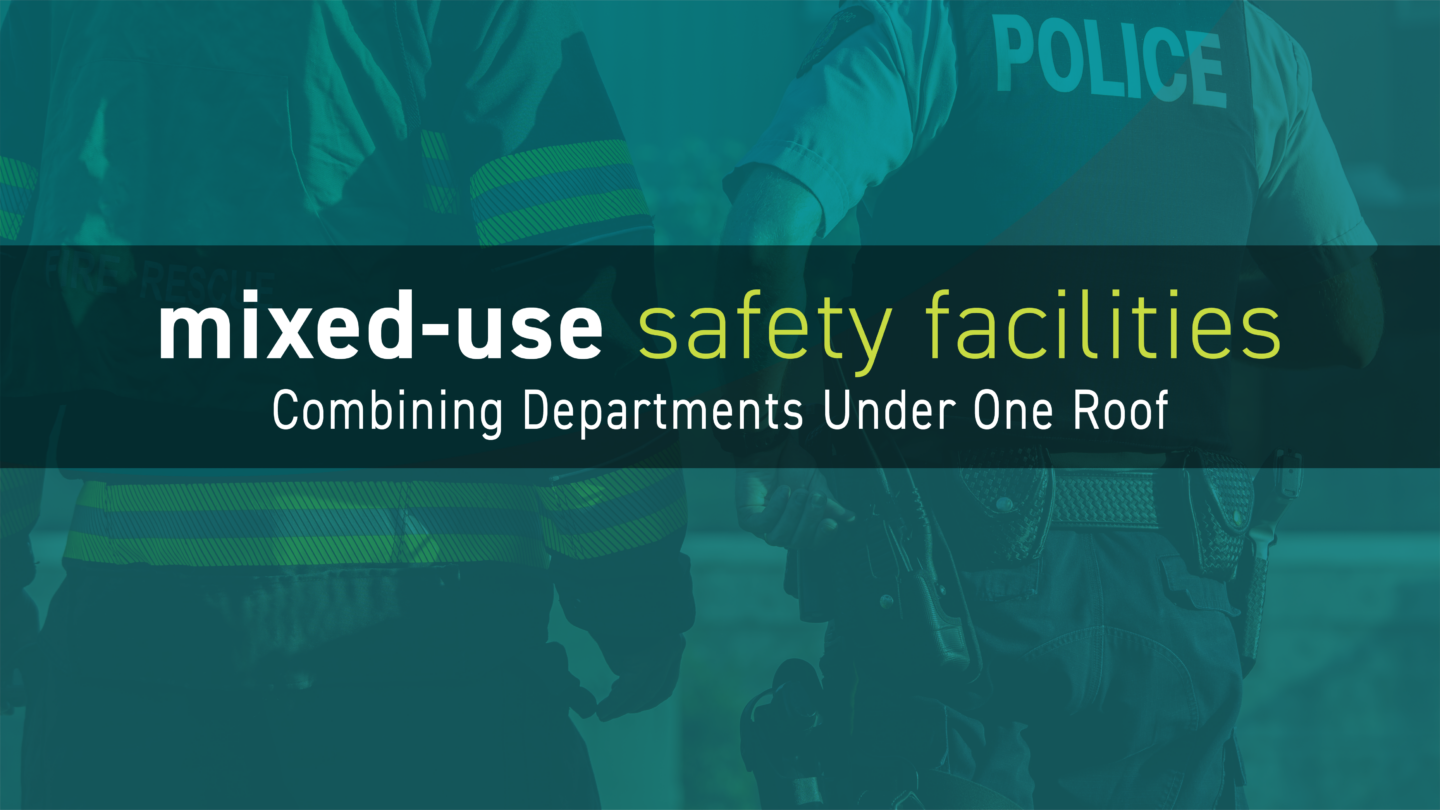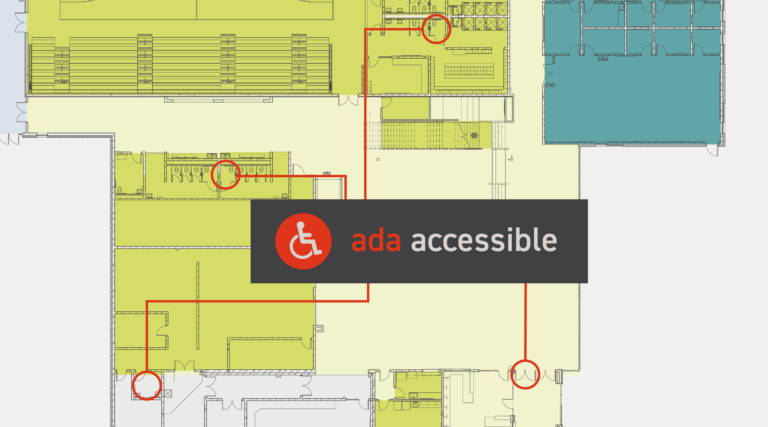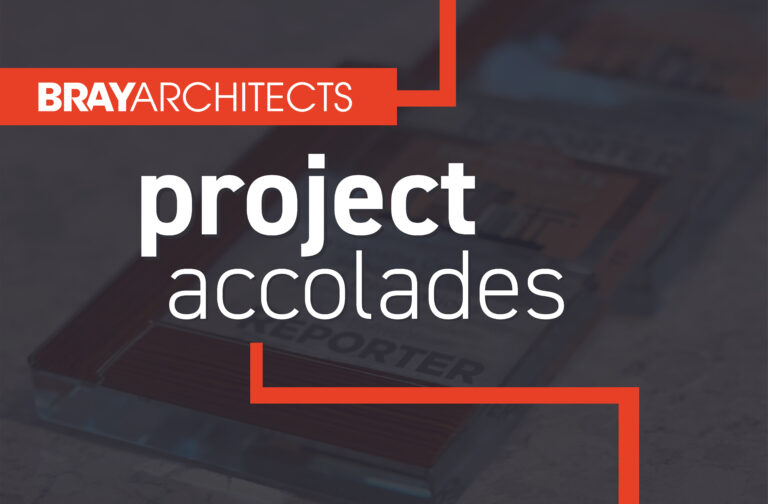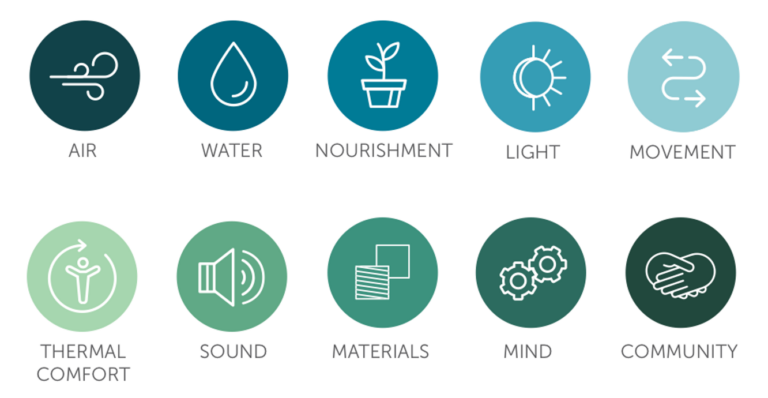A shared public safety facility, housing multiple public-serving departments under one roof, can create logistic efficiencies – reducing operations costs, decreasing response times for emergency vehicles, and offering a central location for citizen needs. A shared space can also unite the departments and offer a symbol of pride and safety for the communities it serves.
Fire Chief Jenny Minter, Police Detective Jennifer Schaaf, and Architect Chris Eger discuss the story behind the Mount Horeb Area Public Safety Building and share considerations and solutions for effective mixed-use safety buildings.
Mixed-use Safety Facility Q+A
What are some of the benefits of combining departments into a shared space?
Chris Eger: Bringing everyone into one building can be excellent for the community – it brings everyone together. When they go on a call, they can leave from the same location, so it provides quick communication and safety. Another prime benefit of a shared facility is maintenance and operational costs. There are many things that can be shared by both departments and it’s an excellent way to bring down the cost for the community as well.
What were some of the reasons the Mount Horeb Joint Fire Department and the Mount Horeb Police Department decided to combine into a shared facility?
Chief Minter: We were working on our own construction project in securing a new building. At that time the village administrator for the Village of Mount Horeb asked if we would be agreeable to doing a combination department with them, [to] which we said, “Sure!” We did a study that showed that we would save over $1 million by combining the buildings together by sharing spaces, so at that point, we pursued that opportunity.
What was the relationship between departments like before this project and sharing the space?
Chief Minter: Before we went into this joint venture, the Mount Horeb Fire Department and the Mount Horeb Police Department are two completely separate entities – our government makeup is different. The Mount Horeb Police Department is part of the village, whereas the Mount Horeb Fire Department is part of the village, seven other municipalities, one other village, and six other townships … So this was kind of our first major project, doing something together to save costs and to share resources.
What are some of the features that were important for your department to include at the beginning of the design process?
Chief Minter: We wanted to include as many training opportunities as we could. Our old building was rather small, and we always had to train outdoors (and in Wisconsin, training outdoors with the weather doesn’t always work out), so training facilities were really important to us. We also wanted sleeping quarters and just more overall space. One of the other features that we wanted to include was an exercise facility. Previously, our exercise equipment was in the apparatus bay behind on of the firetrucks.
Detective Schaaf: Some of the features that we decided to incorporate were fast doors when exiting our garages. We wanted our own booking area where we could both interview and hold people while completing paperwork prior to taking them to our local jail. We wanted enough space for all of our officers and specialized positions so that they had their own stake in the building.
What were some of the safety features that your department considered?
Chief Minter: We wanted to make sure that the “dirty side” of the fire department – housing dirty gear and any clean up after calls – were located on one side of the station, and all of the clean areas were on the opposite side of the station. This way there is no cross-contamination from turnout gear and those type of items into the living quarters and office areas in the station.
Detective Schaaf: We felt it was very important to have panic alarms in key locations around the building – if officers within the booking room or the administrative area up front and something became dangerous, we wanted to give them the ability to get help. We installed panic buttons in the sally port, booking area, and administrative systems up front. We also installed push bar panic alarms in the sally port and booking area that automatically sound off an alarm and delay unlocking for 15 seconds to obtain control of someone who is potentially trying to get away.
Chris Eger: We also wanted to make sure that this building could be a safe area for the community. There is a lockdown area in the vestibule of the building that acts as a secure entrance from potential danger upon entering the building. The training room can also be used as a shelter for community emergencies.
How was the community considered in the design?
Chief Minter: The community was involved from the beginning of the project because we had to pass a referendum for us to secure the funding and move forward with the project. The design process did have some design committees and we continued to keep the public in the loop. We also considered the architecture of other buildings in town, taking some of that Norwegian feel to mirror some of those architectural details in our building here.
In this building, we have some community areas. We have a large training room that can be used for hosted events by the fire and police departments. We also set up the public lobby area for the community with children specifically in mind. We wanted to make sure that there was a nice area to greet school children who are here for tours or for families that may drop by. We worked hard to make that a child-friendly area. There is even small turn-out gear and a truck that they can sit on and pull out the hose.
Detective Schaaf: When talking about where we wanted the building in the community, and since we are a joint department serving different townships and municipalities, it became important to be centralized to all of those communities. We also wanted to make sure that we could respond to calls quickly, which had been a struggle in our previous downtown locations. We also wanted a place that felt warm and friendly and inviting to those who came in.
Chris Eger: The design of the exterior of a safety building really is important for the community. We designed the tower at Mount Horeb to be a beacon of light at night so that anyone in the community could see and locate the safety building.
What are some of the training features in the new building?
Chief Minter: Some of the training features include a section of the mezzanine that is removable so that we can put up our ladders and practice inside. We also have a window that we can use as a bail-out window. There is rigging in place so that the firefighters can safely practice bailing out of a window and repelling down a wall. Some outdoor training features here are a training burn tower with a concrete pad under it for an extrication car so we could safely practice car extrication out there too.
Detective Schaaf: We made sure to include a space for large trainings – training is pretty extensive for us. We needed a training space to bring in other agencies. The shared training room really allowed us to bring in better training opportunities for things like room and building clearing and evidence handling.
Does the police department ever use your training features?
Chief Minter: They do use the training tower for breach and entry training, and they have used some of our vehicles for extrication training as well. Whatever we can share with them, we are happy to share, and they’ve been able to use those resources since they now are our neighbors.
How has the experience of sharing the space been so far?
Chief Minter: Sharing the space has been beneficial to both groups. Before, we didn’t do as many things together. We would see each other on calls, but now it’s really nice to see each other in the halls or in the back parking lot. It’s a lot easier when you need to ask a question – you can just walk across the public lobby. It makes it a lot more interactive.
Detective Schaaf: The relationship between the fire department and the police department has continued to grow close. We’ve always kept an open door, inviting atmosphere amongst both sides and it’s worked to make our departments closer.
We all communicate well. It’s nice to get to know the people who are on the other side of the building. We do frequently respond to calls together, so it’s nice to get to know them outside of those calls. We do get the chance to grill out together and hold shared events together. I would say the benefits outweigh any possible negatives. It has been a fantastic experience for us to be with our fire department.
What are some key considerations or advice that you would give to other municipalities considering a shared facility?
Chief Minter: Open up discussions between the various departments up front. Ask the PD and the FD what type of areas they can share. That will target where those cost savings can come into play. Some areas are easy to share, and others are not as easy to share. I would also recommend that you get design work started early on with an architecture firm, like Bray, so that they can assist throughout the process and help you determine what will work and what won’t.
One of the major hurdles with a shared facility is that is requires a larger land area. You’ll want to make sure that your town or village has enough property available so that it works for all entities involved.
Detective Schaaf: Think about the things that you can share and cut costs on. Maybe talking about those things in advance and come to an agreement while you’re doing the budget, so that you know what kind of equipment you need, where it will be stored, and who will be trained on it. Another thing to think about: if you’re going to put in a lot of windows … make sure you have somebody that can clean those windows (that’s something we didn’t consider ahead of time on either side). It’s important to think about the types of specialty services you’ll need for care of the building later.
Once you are all moved in, you want to make sure that there is good communication about training. When there is a training outside, for example, there is a potential for blocking driveways and aprons. You want to make sure that you communicate well together so everyone is on the same page about when the trainings are taking place and where there may be alternative access for calls.
What are some of the important aspects in coordinating the design of a shared public safety facility?
Chris Eger: It’s making sure you have really strong support characters from the different departments. At Mount Horeb we had really wonderful help form Chief Minter and Detective Schaaf. We couldn’t have designed this building without them. They are integral in our design as are all owners. We really work hard to make sure that we are communicating well with the users of the space and that they are communicating with us on what they need.
Another important aspect in the design of a safety building is the community and bringing in the community during the design process. We’re not only designing for the departments within the building, but also the community itself. I don’t believe that you can design a building without community input. There are several community spaces – museums, community rooms, and additional kitchens – that bring and welcome the rest of the community into this building and makes it theirs as well.
Are you interested in combining departments into a shared space? Connect with us to learn more about how mixed-use facilities can support the needs of your departments and better serve your community.



